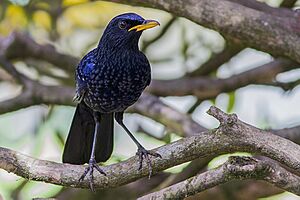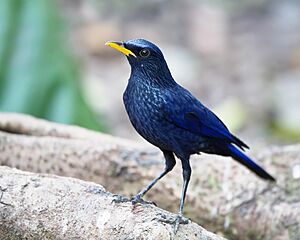Blue whistling thrush facts for kids
The blue whistling thrush (Myophonus caeruleus) is a beautiful bird found in the mountains of Central Asia, South Asia, China, and Southeast Asia. It belongs to the Muscicapidae family, often called "Old World flycatchers." This bird is famous for its loud, human-like whistling song, especially at dawn and dusk.
Blue whistling thrushes are found across a wide area. Because of this, different groups of them can vary in size and how their feathers look. Scientists call these different groups "subspecies." Like other birds in its group, the blue whistling thrush likes to feed on the ground. You can often spot them near streams and in damp places, looking for tasty snacks like snails, crabs, fruits, and insects.
Quick facts for kids Blue whistling thrush |
|
|---|---|
 |
|
| Subspecies temminckii from Pangolakha Wildlife Sanctuary, Sikkim | |
 |
|
| Subspecies eugenei from Royal Agricultural Station, Doi Ang Khang, Thailand | |
| Conservation status | |
| Scientific classification | |
| Genus: |
Myophonus
|
| Species: |
caeruleus
|
About Their Name
Scientists give every living thing a special two-part name. For the blue whistling thrush, this name is Myophonus caeruleus. The word caeruleus comes from Latin and means "blue." This name helps scientists all over the world know exactly which bird they are talking about.
There are also different types, or subspecies, of the blue whistling thrush. These groups might look a little different or live in specific areas. Some of the recognized subspecies include:
- M. c. temminckii: Found from central Asia to parts of China and Myanmar.
- M. c. caeruleus: Lives in central and eastern China.
- M. c. eugenei: Found from central Myanmar to Thailand, southern China, and Indochina.
- M. c. crassirostris: Lives in southeast Thailand, Cambodia, and the Malay Peninsula.
- M. c. dichrorhynchus: Found in the southern Malay Peninsula and Sumatra.
- M. c. flavirostris: Lives on the island of Java.
What They Look Like
The blue whistling thrush is a striking bird. Its feathers are a deep, dark violet-blue. Many of its body feathers have shiny, spangled tips, making the bird look like it's sparkling! However, the feathers around its eyes, on its belly, and under its tail do not have these shiny spots.
The feathers on its wings are a slightly different shade of blue. Some of the wing feathers also have small white spots at their tips. One of the most noticeable features is its bright yellow bill, which stands out against its dark blue feathers. The inner parts of its flight and tail feathers are black. Both male and female blue whistling thrushes look very similar.

These birds are quite large, measuring about 31 to 35 centimeters (12 to 14 inches) long. Their weight can vary, from about 136 to 231 grams (4.8 to 8.1 ounces). To give you an idea, a blue whistling thrush can weigh twice as much as a common American robin!
Interestingly, the size of these thrushes can change depending on where they live. Birds found further north in their range tend to be a bit larger, while those in the south are slightly smaller. For example, in northern China, males weigh around 188 grams, and females weigh about 171 grams. In India, males average 167.5 grams, and females average 158.5 grams.
Where They Live
Blue whistling thrushes live in the Tian Shan and Himalayas mountain ranges. They prefer cool forests and moist montane forests, which are forests found in mountainous areas.
You can find this species in many countries across Asia, including Afghanistan, Bangladesh, Bhutan, Cambodia, China, Hong Kong, India, Indonesia, Kazakhstan, Laos, Macau, Malaysia, Myanmar, Nepal, Tajikistan, Thailand, Tibet, Turkmenistan, Pakistan, and Vietnam. In the Himalayas, these birds sometimes move to lower altitudes during the colder winter months to find food and warmer conditions.
How They Behave
Blue whistling thrushes are usually seen alone or in pairs. They are quite active, hopping on rocks and moving quickly in short bursts. They often turn over leaves and small stones with their beaks, tilting their heads to listen for any movement of prey hiding underneath. If they feel scared or threatened, they will spread and droop their tail feathers.
These birds are active even after the sun goes down. During their breeding season, which is from April to August, they often sing in the dark hours of dawn and dusk. This is when most other birds are quiet. Their alarm call is a sharp, high-pitched kree sound.
They build their nests in a cup shape, using moss and roots. They usually place their nests in a sheltered spot, like a ledge or a hollow next to a stream. A female blue whistling thrush typically lays 3 to 4 eggs. Sometimes, a pair will raise a second group of chicks in the same season.
Their diet includes a variety of foods. They eat fruits, earthworms, insects, crabs, and snails. When they catch snails or crabs, they often hit them against a rock to break them open before eating. In special cases, they have even been seen hunting and eating small birds or mice in the wild.
Scientists have also found that the blue whistling thrush builds a very large nest for a passerine bird (a type of perching bird). Their nests can be about 10.4 centimeters (4 inches) wide, which is one of the largest among the birds studied!


